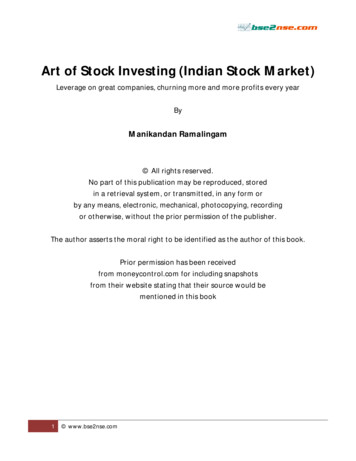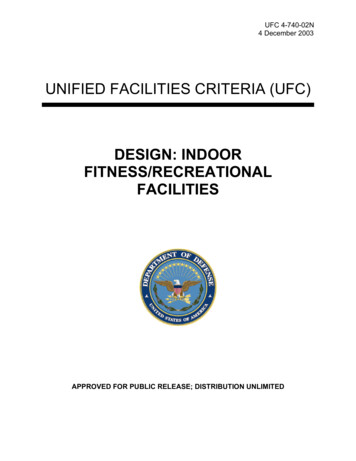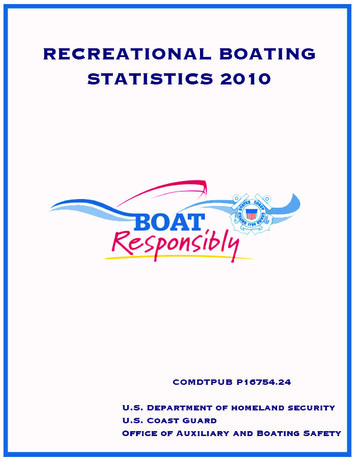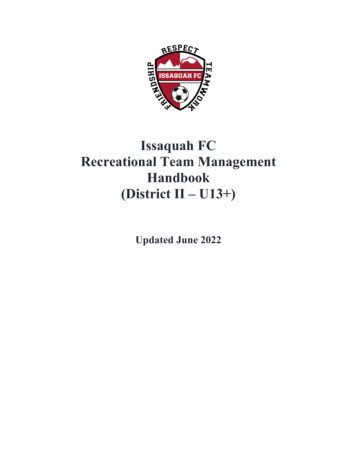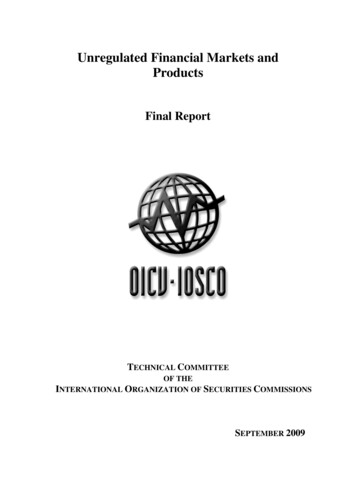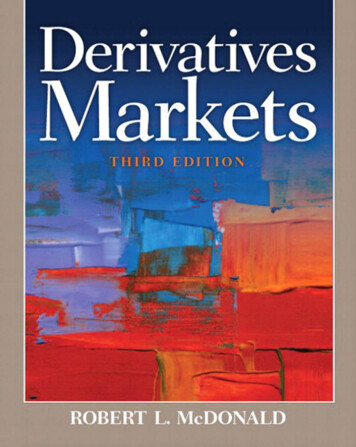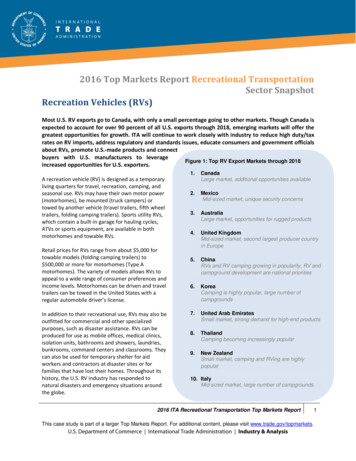
Transcription
2016 Top Markets Report Recreational TransportationSector SnapshotRecreation Vehicles (RVs)Most U.S. RV exports go to Canada, with only a small percentage going to other markets. Though Canada isexpected to account for over 90 percent of all U.S. exports through 2018, emerging markets will offer thegreatest opportunities for growth. ITA will continue to work closely with industry to reduce high duty/taxrates on RV imports, address regulatory and standards issues, educate consumers and government officialsabout RVs, promote U.S.-made products and connectbuyers with U.S. manufacturers to leverageFigure 1: Top RV Export Markets through 2018increased opportunities for U.S. exporters.A recreation vehicle (RV) is designed as a temporaryliving quarters for travel, recreation, camping, andseasonal use. RVs may have their own motor power(motorhomes), be mounted (truck campers) ortowed by another vehicle (travel trailers, fifth wheeltrailers, folding camping trailers). Sports utility RVs,which contain a built-in garage for hauling cycles,ATVs or sports equipment, are available in bothmotorhomes and towable RVs.Retail prices for RVs range from about 5,000 fortowable models (folding camping trailers) to 500,000 or more for motorhomes (Type Amotorhomes). The variety of models allows RVs toappeal to a wide range of consumer preferences andincome levels. Motorhomes can be driven and traveltrailers can be towed in the United States with aregular automobile driver’s license.In addition to their recreational use, RVs may also beoutfitted for commercial and other specializedpurposes, such as disaster assistance. RVs can beproduced for use as mobile offices, medical clinics,isolation units, bathrooms and showers, laundries,bunkrooms, command centers and classrooms. Theycan also be used for temporary shelter for aidworkers and contractors at disaster sites or forfamilies that have lost their homes. Throughout itshistory, the U.S. RV industry has responded tonatural disasters and emergency situations aroundthe globe.1.CanadaLarge market, additional opportunities available2.MexicoMid-sized market, unique security concerns3.AustraliaLarge market, opportunities for rugged products4.United KingdomMid-sized market, second largest producer countryin Europe5.ChinaRVs and RV camping growing in popularity, RV andcampground development are national priorities6.KoreaCamping is highly popular, large number ofcampgrounds7.United Arab EmiratesSmall market, strong demand for high-end products8.ThailandCamping becoming increasingly popular9.New ZealandSmall market, camping and RVing are highlypopular10. ItalyMid-sized market, large number of campgrounds2016 ITA Recreational Transportation Top Markets ReportThis case study is part of a larger Top Markets Report. For additional content, please visit www.trade.gov/topmarkets.U.S. Department of Commerce International Trade Administration Industry & Analysis1
The Nature of the U.S. RV IndustryThere are over 60 RV manufacturers and 200component parts suppliers in the United States.According to the Recreation Vehicle IndustryAssociation (RVIA), the U.S. RV industry has a totaleconomic impact of 49.7 billion, supporting 289,852jobs and generating 5.7 billion in taxes. RVmanufacturers and suppliers are predominately smalland medium-sized enterprises (SMEs). The industry isalso highly concentrated. Over 80 percent of U.S.-madeRVs are produced in Indiana, with the majority in1Elkhart County.Large RV companies have economies of scale inproduction and distribution. Some large motorhomemanufacturers produce their own chassis. Amotorhome chassis typically includes the vehicle frame,engine, transmission, axles, wheels, brakes, coolingsystem electrical system, steering system, suspensionand instrumentation. Most motorhome manufacturerspurchase chassis from third party manufacturers. Smallcompanies compete successfully by concentrating in2specialty products or components.the ages of 55 and 64 have had high RV ownership rateshistorically, customers between 35 and 54 are now thelargest group of buyers. Over 9 million households in4the United States own an RV.Because purchases of RVs are discretionary, demand isstrongly dependent on consumer confidence. As theU.S. economy has recovered over the past several years,purchases of financed non-essential items, such as RVs,have performed better than other categories of retail5spending.RV manufacturers have experienced six years ofsustained growth since 2009, when shipments droppedto a recession low of 165,700 units. During theeconomic downturn, a number of manufacturers wereforced to close or consolidate, and many that surviveddid so by cutting their workforce. Since then, pent-upconsumer demand, an improved economy, low interestrates, available credit, declining fuel prices andfavorable demographics have contributed to continued6growth in the industry.In 2015, RV shipments totaled 374,246 units,representing almost 5 percent growth from theOther notable characteristics of the industry are thatprevious year. Towable RVs made up 87 percent of totalproduction is labor intensive and the workforce is highly shipments and motorhomes the remaining 13 percent.skilled. It is also highly entrepreneurial and innovative as In 2016, the industry predicts that total shipments willmanufacturers increasingly produce lightweight towable again more than double the industry’s 2009 recessionRVs and smaller, fuel-efficient motorhomes. Greenlow and that this trend will continue for the foreseeable7technologies, such as solar panels, are appearing on afuture.3growing number of RVs. The U.S. industry takes greatpride in maintaining that it can build high quality,The RV Industry Export Baseaffordably priced RVs to almost any specification andneed.The United States is the world’s largest producer of RVs,producing more than twice as many RVs as the rest of8RV manufacturers are subject to a number of state andworld combined. Because domestic demand has beenfederal regulations and standards. RV standards include so strong in recent years (temporarily exceeding supplyat times), many manufacturers have not soughtthose for electrical and fuel systems, fire and safety,opportunities in other markets, with the exception ofplumbing systems and Federal Motor Vehicle SafetyCanada.Standards (National Highway Traffic SafetyAdministration, U.S. Department of Transportation).RVIA’s members are required to build to the NFPA 1192 Although some companies, particularly largemanufacturers, have been actively involved in exportingStandard on Recreation Vehicles and self-certifytheir products, many small and medium-sizedcompliance to the standard. RVIA has inspectors thatcompanies have focused their attention almostperiodically audit manufacturer compliance to theexclusively on the domestic market. Other SMEs arestandard.unaware of overseas opportunities. A current U.S.exports-to-shipments ratio of less than 10 percentRV demand is highly dependent on demographics andfurther illustrates that exports do not yet play aconsumer income. Consumers, in increasing numbers,significant role.are reaching the ages when they want to travel andcamp in RVs. While middle-income consumers between2016 ITA Recreational Transportation Top Markets ReportThis case study is part of a larger Top Markets Report. For additional content, please visit www.trade.gov/topmarkets.2
While the RV industry anticipates strong growth tocontinue in the near-term, market conditions couldchange with an economic downturn - similar to whathappened in 1980, 1990, 2001 and 2009, when9wholesale shipments declined substantially. Increasedindustry involvement in exporting could help offsetpossible future slowdowns and declines in domesticdemand.Growing numbers of middle-class consumers withincreasing discretionary income in a number ofcountries, particularly emerging markets, providetremendous opportunities for U.S. exports of RVs. Also,rising numbers of consumers in these countries arebecoming interested in RVs, camping and the “RVlifestyle.” For a number of U.S. manufacturers that havebeen involved in exporting, much of their attention todate has focused on emerging RV markets in Asia –particularly China, Korea and Japan.While U.S. RV manufacturers face competition inemerging markets from European manufacturers(particularly German and Slovenian), many consumersprefer U.S.-made RVs because they can be outfittedwith features that European models cannot provide at acomparable price. European-built RVs do not have slideouts and tend to be smaller and more expensive thanU.S. models.Today, over 90 percent of U.S. RV exports are toCanada. Exports to the other nine largest markets aresmall. While Mexico is the second largest market, itrepresents just over 2 percent of U.S. exports. Fivemarkets - Australia, United Kingdom (U.K.), China, Koreaand United Arab Emirates (UAE) - each account forabout 1 percent of exports. The remaining markets Thailand, New Zealand and Italy - account for smalleramounts.Although current RV exports to most countries (exceptCanada) are small, export values can changesubstantially from year-to-year, depending on the typesof RVs exported. For example, a large order ofmotorhomes exported to a country one year couldresult in higher export values for the period comparedto the same number of towables the next year.In 2015, U.S. exports of RVs totaled 1.2 billion. Themajority of exports (74 percent) were towable RVs(travel trailers), campers and other models. Twenty-sixpercent of exports were motorhomes. ITA expects U.S.RV exports to increase to 1.4 billion in 2018, with acompound annual growth rate (CAGR) of 5 percent.Canada will continue to be a key destination for U.S. RVsthrough 2018, capturing over 90 percent of all U.S.exports.Optimizing U.S. LeverageITA anticipates the greatest growth for U.S. exports tobe in emerging markets, particularly China and Korea. Inaddition to increasingly favorable demographics andmarket conditions, growing consumer interest in RVsand camping, large numbers of existing campgrounds(Korea) and government efforts to promote tourism anddevelop RV and campground dedicated regulations(China) should enable opportunities for U.S. exports togrow in these countries.In 2015, RVIA received a second, consecutive three-yearMarket Development Cooperator Program (MDCP)award from ITA to grow exports in China, Korea andJapan. RVIA’s objectives under the award includeprograms and initiatives to: pursue adoption of RV and campground industrydeveloped standards compatible with U.S.-madeRVs to ensure market access for U.S. exports; pursue the inclusion of RV definitions in the ChinaMotor Vehicle Code; pursue the development of reasonable RV road useregulations, address licensing and registrationissues and remove regulatory obstacles; pursue the reduction of import duties and tariffs onRVs; increase demand for U.S. RVs and post-disasterrelief and recovery products; educate the Chinese and the Koreans on RVing andcamping and RVIA members on exporting; and ensure the U.N. Economic Commission for Europe(UNECE) World Forum for Harmonization of VehicleRegulations will not effectively lock U.S. RVs out ofcountries adopting the UNECE standard.Under RVIA’s 2012-2015 MDCP award, RV exports toChina, Korea and Japan exceeded 143 million.Continued U.S. government support of RVIA’s 20152018 MDCP award and programs and initiatives in thesecountries will help increase opportunities for U.S.exporters in both the near and long-terms.In addition to its partnership with ITA as an MDCPcooperator, RVIA is also a strategic partner with ITA.This important affiliation, which began in 2013, allowsthe association’s members enhanced access to ITA’s2016 ITA Recreational Transportation Top Markets ReportThis case study is part of a larger Top Markets Report. For additional content, please visit www.trade.gov/topmarkets.3
global resources and increased opportunities in exportmarkets. Continued U.S. government support of RVIA’spartnership under this program will further enhanceongoing efforts to assist U.S. companies.have a designated industry category for RVs, adding tothe challenge of separating them from the requirementsimposed on other motor vehicles or recreationalproducts.U.S. government services, such as the Gold Key andPlatinum Services provided by CS, can also help leverageadditional opportunities for U.S. companies. In the past,RVIA has utilized a Gold Key service in China and, morerecently, a Platinum Service in Japan for its initiatives toprovide Japan with post-disaster assistance and developmodel campground sites in disaster areas.China, and possibly other markets, has looked to adoptInternational Organization for Standardization (ISO)standards for RVs. ISO standards, however, have notbeen updated the way U.S. and European standardshave to incorporate current safety and productionneeds for RVs. Adding to this challenge, ISO andEuropean standards often are not compatible with U.S.RVs.The participation of foreign buyers in ITA’s InternationalBuyer Program (IBP) trade shows is highly effective inintroducing the buyers to U.S. manufacturers andproducts. The U.S. RV industry’s annual trade show, theNational RV Trade Show (www.rvia.org), an industryonly trade show that will be held from November 29 toDecember 1, 2016 in Louisville, KY, is an IBP-Selectevent (as were the 2015 and 2014 shows). U.S.government efforts to bring foreign buyers to the showwill provide increased export opportunities for U.S. RVmanufacturers and suppliers.Because relatively little is known about RVs in manyemerging markets, opportunities to promote RVs andeducate consumers and government officials about U.S.products and the RV lifestyle should play a crucial role inU.S. government and industry collaborative strategies.Trade promotion opportunities, such as outdoorlifestyle events, trade shows and other events thatenable the showcasing of U.S. RVs, will enable publicofficials and consumers to learn more about U.S. RVs.Standards developed by U.S. domiciled standardsdeveloping organizations (SDOs) provide for excellentsafety as demonstrated by the industry’s performancerecord. These standards allow for maximum designflexibility, which allow for an array of RV products to bebuilt for consumers.Despite the challenges, ITA encourages exporters tofocus their efforts on emerging markets, as these havethe greatest opportunities for growth in the long-term.Countries that have Free Trade Agreements (FTAs) withthe United States provide particularly advantageousopportunities, as these have fewer restrictions,including reduced or no import duties for RVs.ITA will continue working collaboratively with the U.S.industry to develop strategies that are specific for eachmarket. As noted, coordinated U.S. government andindustry efforts are already underway in several keyemerging markets – China, Korea and Japan.While there is strong potential for increased growth forU.S. exports, RV exporters face challenges in emergingmarkets. A number of countries have neitheradequately developed campsites (electric hook-ups,water and sanitation infrastructure, etc.) nor highwaysto accommodate RVs. Further, because RVs areconsidered luxury items in some countries, they aresubject to restrictive tariff and tax combinations, whichlimit U.S. exports to these markets. Concerns aboutcrime also are a unique factor in some countries.Country studies and snapshots of the RV markets inAustralia, Canada, China, Europe (Czech Republic,France, Netherlands, Slovak Republic, Sweden andUnited Kingdom), Korea and Japan follow this section ofthe Top Markets report. Snapshots of the RV markets inChile, Colombia, Kenya, Taiwan, Thailand and Turkey arebelow. Information from RVIA and ITA USFCS officeswas used for these studies.U.S. RV exports also often face a lack of regulation inoverseas markets or inconsistencies between existingstandards. These generate confusion among RVmanufacturers and suppliers, consumers andgovernment agencies and impede market access forU.S. manufacturers. Most emerging markets do notChileRV Market SnapshotsThe current RV market in Chile is small. Though Chilehas two major RV manufacturers, the domestic marketis comprised primarily of imported or used RVs. In 2014,RV imports in Chile totaled 4.5 million.2016 ITA Recreational Transportation Top Markets ReportThis case study is part of a larger Top Markets Report. For additional content, please visit www.trade.gov/topmarkets.4
Despite its small size, the domestic RV market isgrowing little by little. Twenty years ago Chile did nothave one suitable campground for RVs. Today, it hasfour campgrounds equipped for motorhomes–three inthe North of the country and one in the South. Othercampgrounds may allow motorhomes; these typicallydo not offer special connections for RVs.Similar to other emerging markets, Chile does not havededicated regulations for RVs. Under the Chile-U.S. FTA,there are no import duties on RVs–importers are onlysubject to a 19 percent value-added tax (VAT).Though the RV market in Chile is small, ITA believes itcould provide increased opportunities for U.S. exportersin the long-term. With demand for RVs and campgrounddevelopment growing and its status as an FTA partnerwith the United States, Chile is a potentially favorablemarket for U.S. companies. In 2015, U.S. RV exports toChile totaled 1.3 million. Towables were the largestcategory of exports (58 percent).ColombiaIn 2015, U.S. RV exports to Colombia totaled less than 500,000. Motorized RVs were the largest category ofexports (95 percent). At present, Colombia does nothave any campgrounds for RVs. Local companies thatsell RVs, however, have signed partnerships with somenational parks so that their vehicles are allowed in thecampgrounds. There are two major manufacturers anddistributors of RVs in Colombia.TaiwanRVs have experienced very limited market growth inTaiwan due to the country’s limited space for parkingand underdeveloped camping facilities. There are 38campgrounds across the country, but most areunderdeveloped. The total number of RVs in Taiwan isless than 200 units. The Formosa Camping &Caravanning Club represents the interest in campingand RVing in Taiwan.ThailandThailand currently does not have an established RVmarket. While there are a small number of caravans,camper vans and motorhomes in Thailand, most RVs areprivately imported for personal use by individuals,groups of users (mostly wealthy families) or assembledlocally by foreign companies and local pick-up truckassembly companies.There are approximately 20 campgrounds across thecountry. Most of these are owned and managed byprivate resorts, and some are operated by the Thailandgovernment national parks. Additional informationabout RV parks in Thailand can be found at:http://thairv.com/board/index.php?board 5.0.Five RV manufacturers in Thailand producemotorhomes, camping cars, caravans, and otherproducts. Thailand does not have dedicated regulationsfor RVs.The current RV market in Colombia is somewhat limited.Security concerns in the country make RVs a target forcriminals. For this reason, Colombians generally try toavoid driving vehicles that may appear to be luxuryitems.Currently, Thailand does not have any official groups orassociations that represent the RV industry. However,RV owners and consumers use the following website tocommunicate and share information about RVs, RVparks and buying/selling RVs: www.tairv.com.While there is not a dedicated trade show for RVs, localdistributors have exhibited in the Salon Internacionaldel Automovil Trade Show in Bogotá. Though thecurrent market in Colombia may be limited for RVs, ITAbelieves that it could provide opportunities for U.S.exporters in the long-term. A growing middle class withincreasing levels of discretionary income and its statusas an FTA partner with the United States makeColombia a potentially favorable market for U.S.companies in the long-term.Camping is becoming increasingly popular in Thailand,driven by expanded parking areas in national parks andresorts. The popularity of camping is expected to riseeven more once the Association of Southeast AsianNations Economic Community (ASEAN) is fully10implemented. Though there are not any dedicated RVshows in Thailand, a few motor (automotive) showsfeature a designated area for RVs. These include theThailand International Expo and Bangkok InternationalMotor Show.While Thailand currently does not have an establishedRV market, camping is becoming increasingly popular.2016 ITA Recreational Transportation Top Markets ReportThis case study is part of a larger Top Markets Report. For additional content, please visit www.trade.gov/topmarkets.5
This trend, combined with a growing middle class, makeThailand a potentially favorable market for U.S.companies in the long-term. In 2015, U.S. RV exports toThailand totaled 4.7 million. Motorhomes were thelargest category of exports (95 percent).TurkeyThere are 109 campgrounds in Turkey. Fifty-six of theseare registered with the Turkish Camps and CaravanAssociation, www.kamkaravan.org.tr//index.php . In2010, according to the Turkish Statistical Institute (TUK),the number of nights spent in caravans and camps byforeigners was 467,978. Total production of caravans inTurkey is estimated to be a couple of thousand units peryear by the country’s 10 manufacturers.Caravans in Turkey are subject to a Special ConsumptionTax (OTV), which is very high (145 percent). Also,mandatory insurance on caravans is quite high,approximately 10 times more than for a regularautomobile. Turkish Camps and Caravan Associationofficials are trying hard to solve some of the majorchallenges to increase interest and the market forcaravans. Industry experts believe the market will growif these can be resolved.The ATRAX Expo (December) in Istanbul, an amusementparks and recreation show, includes partial coverage ofRVs. Also, some caravan manufacturers exhibit at theIzmir Tourism Fair (December). In 2015, U.S. RV exportsto Turkey were less than 800,000.1RVIA represents over 98 percent of U.S. RV manufacturers and component parts suppliers. RVIA members alsoinclude manufacturers of park model RVs. For additional information about RVIA and RVs, see www.rvia.org andwww.gorving.com.2“Recreational Vehicle Manufacturing Industry Profile,” First Research, Hoover’s Inc., January 12, 2015.3RVIA.4Ibid.5Anna-Louise Jackson and Anthony Field, “Rebound in Sales Portends, Rising U.S. Boats: EcoPulse,” Bloomberg,July 14, 2014.6Bruce Schreiner, “Rolling Along: RV Industry Maintains Momentum,” Yahoo Finance, January 24, 2015.7In 2016, RV shipments are expected to total 381,800, an increase of two percent from 2015. RV Roadsigns, Spring2016; RVIA.8Ibid. The United States is followed by Europe and Australia.9Jeff Parrott, “Leaders in RV, Elkhart Country Industries Anticipate Next Economic Downturn,” The Elkhart Truth,December 14, 2014.10“More Camping Grounds Ignite Motorhome Popularity,” Bangkok Post, April 15, 2013.2016 ITA Recreational Transportation Top Markets ReportThis case study is part of a larger Top Markets Report. For additional content, please visit www.trade.gov/topmarkets.6
Figure 1: Top RV Export Markets through 2018 1. Canada Large market, additional opportunities available living quarters for travel, recreation 2. Mexico Mid-sized market, unique security concerns 3. Australia Large market, opportunities for rugged products 4. United Kingdom Mid-sized market, second largest producer country in Europe 5. China

